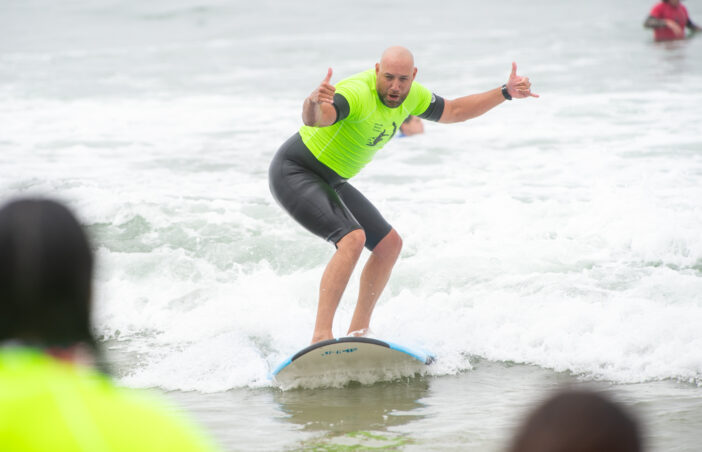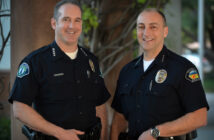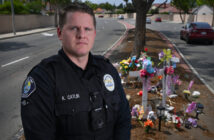As the wave gathered behind him, Donovan Torres, perched on a surfboard for the first time in his life, began flapping his arms like a baby seal. Behind Torres, an instructor guided the tail of the board into the developing curl. Torres clambored to a standing position, arms still pinwheeling, legs skittering like a newborn pony. As he gained his balance in the whitewater near shore, Torres managed to look at his family, grinning and flashing a “shaka” hand signal.
The Manhattan Beach police officer was having the time of his life in his maiden surfing experience.
The opportunity at El Porto Beach came via an event set up by Manhattan Beach PD Capt. Andrew Enriquez and approved by Chief Rachel Johnson with the nonprofit Jimmy Miller Memorial Foundation.

Manhattan Beach Police Chief Rachel Johnson,left, is congratulated by Valerie Swanson, mother of fallen Manhattan Beach officer Chad Swanson, after Johnson caught a wave, at a wellness surf session for first responders, hosted by the Jimmy Miller Memorial Foundation, at El Porto in Manhattan Beach Calif, Friday, July 26, 2024.
The event memorialized Manhatta Beach motor officer Chad Swanson, who was killed on duty October 4, 2023.
Photo by Stephen Carr
For the past 20 years, the Foundation, a leading nonprofit in what it calls ocean therapy, has used surfing as a holistic method to improve health – mental and physical – for diverse communities.
Torres was one of a dozen Manhattan Beach officers and personnel who gathered for the event and to commemorate motorcycle officer Chad Swanson, who died in a crash while on his way to work in October last year.
For Torres, a veteran School Resources Officer, Swanson was more than a colleague, he was a neighbor and close friend.
If only for a bit, Torres was able to wash away the grief and, possibly, found a new outlet for dealing with stress and loss.

Manhattan Beach Police Department first responders and ocean therapy volunteer participate in a talking circle, during a wellness surf session, hosted by the Jimmy Miller Memorial Foundation, at El Porto in Manhattan Beach Calif, Friday July 26, 2024.
Manhattan Beach PD memorialized officer Chad Swanson, who was killed on duty October, 2023.
Photo by Stephen Carr
Toes in
Sometimes it’s as easy as dipping a toe. The Jimmy Miller Memorial Foundation operates on the premise that recovery from trauma has to begin somewhere. And few places on this great blue planet have the curative powers of water and the ocean.
That’s why an estimated 100 million people flock to the Southern California seaside annually, whether to surf, swim, splash, explore the edges, or just breathe in the salt air and watch the sun settle below the horizon.
The Foundation has introduced surfing as therapy to groups ranging from underprivileged youth, to disabled people, to veterans suffering from injury and trauma. In November, the Foundation started reaching out to members of law enforcement and first responders.
The event honoring Swanson was its latest.
Stuart Scott, a fellow Manhattan Beach motorcycle officer, said remembrances like this were important because all too often, ”you don’t get a chance to process.”
The Manhattan Beach event also helped bring some measure of healing for Swanson’s parents, Valerie and Kip, who wore matching “Baker to Vegas, Team Swanson,” t-shirts commemorating their son at a recent law enforcement running event.
“It’s painful, but it’s powerful,” Valerie said of the effect of the memorial events.
Matt Domyancic, a former SWAT Officer now known as the Tactical Chaplain, said it’s important for officers to avail themselves of help early rather than waiting.

Manhattan Beach Police Department first responders participate in an ocean therapy event, hosted by the Jimmy Miller Memorial Foundation, at El Porto in Manhattan Beach Calif, Friday July 26, 2024.
Manhattan Beach PD memorialized motor officer Chad Swanson, who was killed on duty October, 2023, while learning about surfing and the therapeutic benefits of ocean activity.
Photo by Stephen Carr
“If you wait until you have PTSD, the ship’s a lot harder to turn around,” he said.
The idea of the sea as curative is not new.
In “Moby Dick,” Herman Melville’s Ishmael said when he felt, “a damp, drizzly November in my soul,” it was “high time to get to sea as soon as I can.”
Called FROPOWR, an acronym for First Responders Oceanic Performance Optimization Wellness & Resiliency, the events for first responders are designed to introduce surfing and therapy.
However, you’ll notice the word therapy is nowhere to be found in the event title.
As Andy Dellenbach, CEO of the Jimmy Miller Memorial Foundation notes, “If we call it therapy, no one will show up.”
By rebranding it as “performance optimization,” Dellenbach says the Foundation is able to engage in what he calls “ninja therapy.”
Or, as he added, “A certain amount of therapy without realizing it. It’s an easy opportunity to try something without the stigma.”
In a number of high-stress occupations, such as law enforcement, concepts of wellness have been leaned into wellness in recent years. This can be done through stress-relieving physical activities, department get-togethers and outings, and, for those who wish, psycho-therapy.
However, erasing stigma is no easy chore, which is why substance abuse, marital strain, and suicide remain stubbornly high and very real perils of the job.
For many, there is an elemental connection to water and the ocean.

Manhattan Beach Police Chief Rachel Johnson catches a wave as Manhattan Beach Police Department first responders participated in an ocean therapy surf session, hosted by the Jimmy Miller Memorial Foundation, at El Porto in Manhattan Beach Calif, Friday, July 26, 2024.
Manhattan Beach PD and first responders memorialized officer Chad Swanson, who was killed on duty October 4, 2023, and felt the healing power of surfing and the ocean.
Photo by Stephen Carr
Fighting for mental health
Events like those in Manhattan Beach are the kind of thing Miller, an avid waterman and surf instructor who died by suicide in 2004, would have loved, say his family and friends. After Miller’s death, his mother, Nancy, helped start the foundation in Miller’s memory to support surfing and those struggling with mental and physical challenges.
Nancy Miller said that since her son’s death, she has discovered the allure of surfing and water sports.
“I learned to surf at 50.” she said. “Once I understood what it was and how it makes you feel inside and out, it changes people.”
“Out of tragedy a group of us bonded together to keep his memory alive,” said Dellenbach, a lifetime friend of Miller. “We started a foundation not even knowing what it was.”
All they were sure abouty was the desire to prevent others from sliding into the mental illness that took Jimmy away.
At about that time, Dr. Carly Rogers, an early leader in the Foundation, was beginning some groundbreaking clinical work and research into the therapeutic properties of surfing and ocean activity.
By its nature, she knew that surfing requires full-body and sensory immersion. It engages strategy and environmental awareness. And it’s one of the best all-body workouts imaginable.
Some of Rogers’ research was based on the theories of flow and optimal experience.
Being in a state of flow floods the brain with mood-lifting neurochemicals such as anandamide and serotonin. The ocean releases negative ions, which instill feelings of well-being.
In a Ted-X presentation at UCLA on the subject, Rogers said participants in ocean therapy sessions may not become regular surfers. However, she said, if the experience leads to a self-empowering moment of, “I did it, what else can I do? That’s the goal.”

Nancy Miller, left, comforts Valerie and Kip Swanson, parents of fallen Manhattan Beach Police Officer Chad Swanson, during a talking circle at a meomorial and ocean therapy event for Manhattan Beach Police Department first responders, presented by the Jimmy Miller Memorial Foundation, at El Porto in Manhattan Beach Calif., Friday, July 26, 2024.
Nancy Miller is a founding member of the Jimmy Miller Foundation, created 20 years ago to battle mental illness and trauma after Jimmy Miller died from suicide. Manhattan Beach PD and first responders learned about the healing powers of the ocean and surfing as they memorialized fellow officer Chad Swanson, who was killed on duty in October, 2023.
Photo by Stephen Carr
Doorway to therapy
Trickery? Maybe a little bit. The FROPOWR events are only a little touchy-feely, centered mostly on surf training and the ocean experience.
However, before entering the water, attendees gather in a “sharing circle,” complete with a totem passed among them. So, yeah, a little 1970s-ish therapeutic talking is built in.
During the circle, led by Ocean Therapist Elizabeth Holmberg, participants shared thoughts on the theme of sacrifice, as well as memories of Swanson.
The ocean therapy programs have shown measurable successes and have been exported internationally, with programs in the United Kingdom, Spain, Germany, and France. Dellenbach said the goal for the Foundation is to continue to expand up and down the coast.
Rogers reported that after ocean therapy sessions were staged with the military, some participants entered therapy sessions or programs with spouses, and sought out programs to battle substance abuse.

Manhattan Beach Police Department paddle out during an ocean therapy surf session, hosted by the Jimmy Miller Memorial Foundation, at El Porto in Manhattan Beach Calif, Friday July 26,2024.
Manhattan Beach PD and first responders memorialized fellow officer Chad Swanson, who was killed on duty October ,2023.
Photo by Stephen Carr
At the Manhattan Beach event, in addition to the surfing, there was also a paddle out, in which the officers and volunteers formed a circle in the ocean to remember Swanson.
Then it was time for some frothy therapy of the surf.
Chief Johnson got to her knees and beamed as she rode a wave to shore.
And Torres, although not quite ready to go all “kowabunga, dude,” admitted, “I definitely feel the healing power. It’s super, especially sharing it. It brought me closer to the water and closer to my peers.”
Which is the point. Organizers stress the purpose isn’t to proselytize, advocate, or even suggest therapy.
However, if the sessions help lead officers who may be dealing with trauma to consider formal therapy, so much the better. If it simply introduces a healthy, stress-relieving, positive lifestyle choice, that’s not bad either.
It all starts with a toe in the water.
 Behind the Badge
Behind the Badge



